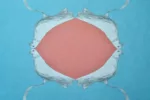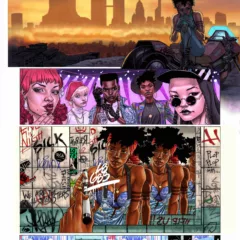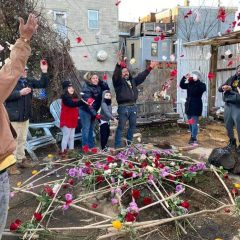[Ed. Note: This is the second post in a 2-post series about the 2022 Grantees of the Velocity Fund. See the first post here.]
Author’s Preface
I was honored to interview 2022 Velocity Fund Grantees — Amelia Carter (“Spirit on 52nd St.”), and UNDUE BURDEN. I’ve talked with many awardees over the years and each one of them is a visionary. And they all share a deep felt commitment to collaboration and to Philadelphia, its people, its quirks and beauties. Whether they are documenting the lives of the Disabled or filming residents and business-owners in West Philadelphia, the Velocity Fund Grantees are artists you want to know, doing projects that deserve support and audiences. They are veritable community projects, made with collaboration and energy, and filled with positivity, energy and hope. Philadelphia needs such generous, positive and hopeful artists and their projects now more than ever as the arts community re-groups and moves forward after the pandemic. Below are the interviews, lightly edited for length and clarity. I look forward to seeing these projects evolve and grow.
Shannon Brooks – UNDUE BURDEN
UNDUE BURDEN is a digital community archive and exhibition series created by Disabled people in Philadelphia. More here
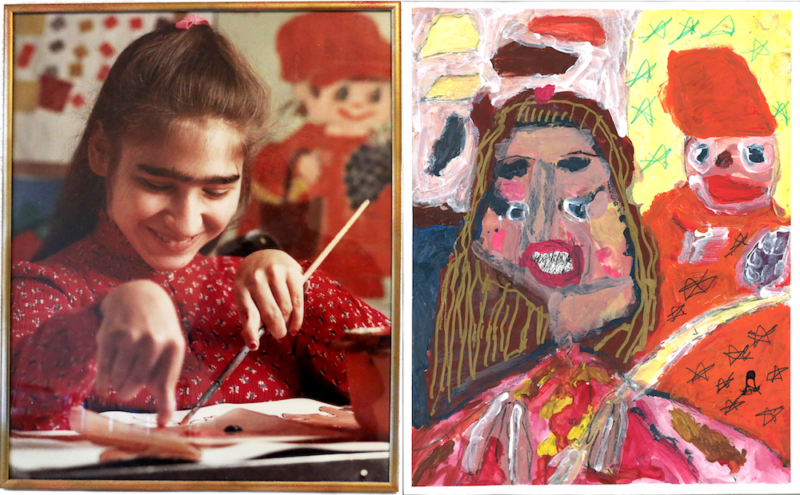
Image ID: Two images side by side.
The left image is a young Pam in a bright red dress painting at a desk. She is smiling and has long brown hair pulled back into a half-up hairstyle. She holds a paint brush in her left hand making a diagonal line cutting across the image with the brush handle. Her right hand is used to steady her motions. There is a picture of a cartoon boy in a red dress in the background.
The right image is a painting of the photograph from Pam’s archive titled “Pam at Melmark.” The painting is 16 inches by 20 inches and is created on watercolor paper using acrylic paint, quill pen, and paint markers. The painting shows Pam’s face and arms in the foreground. Pam is smiling and holding a paintbrush. She is wearing a red and yellow shirt. She has peach skin and brown/gold hair. Over Pam’s left shoulder is a depiction of a smiling figure with a red shirt and red hat, holding a bunch of grapes. The figure has black stars on their shirt and behind them is a yellow background with blue stars. Over Pam’s right shoulder is a depiction of collaged yellow, orange, brown, and blue shapes on an off-white background.
Roberta Fallon: I’m talking with four members of the UNDUE BURDEN team. Can I ask you to introduce yourselves? I’ll start by saying I was an English major that came to art later, no degree in art. I made art collaboratively, and Artblog is an outgrowth of that collaboration.
Maggie Mills: I’m Maggie Mills. I’m an Assistant Professor, part of the Philadelphia art community, part of the disability community as well, and was able to find these beautiful people to collaborate with.
Shannon Brooks: I’m Shannon, they/she, I’m an artist living in Philadelphia. I create
interdisciplinary experiences with movement, performance, and film. I believe Disability and access are generative forces that can change time, space, and power structures. In 2020, I was furloughed from my job as a care worker and was a part of creating Hook&Loop, a collective of Disabled, chronically ill, mad, and neurodivergent people and artists (H+L). And UNDUE BURDEN is an ongoing project of H+L. H+L meets online every week for one hour to do whatever we want online like celebrating with dance/music, creating art together, venting about and offering support in navigating the medical industrial complex, and organizing accessible events.
Dove: I’m Dove: they/them. I’m located in Baltimore, a hop and a skip away from Philly. And Philly folks are very near and dear to my heart. I’m a disability justice organizer as well as an access doula and a peer supporter. My background is in performance art, installation and writing, and it shifted drastically when the pandemic hit in 2020. I was graduating from my BFA at SAIC (School of the Art Institute of Chicago). I was a curator and working on performance creation projects and ended up having to shift back to the East Coast after being laid off. So I’ve been primarily organizing remotely. As an imuno-compromised person I cannot really be out in a world that is not built for us.
A lot of the art community has become even more inaccessible than it was before and I have only been making art for myself for once, which is also a very beautiful thing. I haven’t been in a gallery setting or anything of that nature going on four years now. But making this connection with Hook&Loop through Shannon has been really beautiful in terms of trying to broach the connection of getting back into organizing around the arts, something I have been missing for a long time, with a particular focus on Disabled artistry and recording those histories. I also do a lot of mutual aid organizing focused around mask distribution and Covid advocacy. I’m working with a couple projects right now to try to put pressure on medical centers that have been dropping their mask mandates and protections. I have my hands in a lot of different pots. I’m very grateful to be in this tender group as well, and I care about these folks so much, so it gives a place for the anger for sure.
Andrew Keller: I’m Andrew Keller: he/him. I was also an English major as an undergrad at Rutgers Camden, and I got my start in art world stuff with Painted Bride Quarterly, which was at the time at Rutgers Camden, then moved to Drexel University. I was a part of PBQ a long time, from maybe 2006–2016. Then I felt it was time to move on. Now, I spend a lot of time thinking about music. I was in the band Hermit Thrushes (they don’t exist anymore — broke up about a year ago for various reasons, world music to pop). And the band Snow Caps (pop-oriented) now. That’s the one that I write the music for these days. And I’ve also been on disability for I would say 13–14 years. So that’s just a way of sustaining me through art practice. I came to H+L through Shannon and I’m really happy that I did. I got to meet a bunch of great people who are very supportive.
Shannon: We want to note that many people and voices that make up Hook&Loop and UNDUE BURDEN were not able to make this call. We are a wide network of creators. The four of us are just the people who have access to a computer at this time.
Maggie: Accessibility is the overarching tie that binds us, and it’s important for us to acknowledge all the forms of access that were available to the four of us to be here today that may not be available to other people.
Roberta: Maggie, how did you find Shannon and Hook&Loop and UNDUE BURDEN?
Maggie: I’ve been organizing in the healthcare space for a few years and I write about healthcare and disability, social security and those kinds of things. I contacted Shannon about an event I was helping with. I also had issues with the number of inaccessible art spaces in Philadelphia. There are whole groups of people who can’t even enter these spaces because of inaccessibility.
I’m also immunocompromised and haven’t been able to be in these spaces for a while. Dove and I commiserate quite a bit. It’s become really clear to me that I need to be part of organizations that forefront accessibility. It’s been wonderful to collaborate with everyone. Shannon drew me into the project.
Shannon: (chuckles) Hook&Loop applied for a residency with an artist collective without knowing there wasn’t an elevator in their studio’s building. We got the residency, but it was inaccessible. We said, “If you want us to be in residency here, find us another space.” And after a year or so the collective moved to a more accessible studio and we were able to have our residency. Which is a great example of commiting to access — their team was so great to work with and truly valued making space for Hook&Loop! However, even with creating more physically accessible events, we are always also interested in creating more intentional remote programming.
Maggie: So many places are inaccessible in so many ways, and I wish this was unacceptable to all of us.
Shannon: Right, and I think UNDUE BURDEN and Hook&Loop are ways we can get together, collect the data (through the digital archive we’re creating) and process what is happening: the effects of inaccessibility, and how we want to transform our environments and social/economic structures. The lives of Disabled people have historically been pathologized, strategically forgotten, and told for us. And the archiving processes we are creating through UNDUE BURDEN put us in charge of our stories.
Roberta: Can I ask, what do the words “Hook&Loop” mean to you?
Shannon: Lily Feingold came up with that name and designed our logo. She is a stained glass artist in Philly and a close friend. We have always connected over our different experiences with disability. I believe Lily was thinking about different types of hooks and loops that show up in accessible technology — Velcro, in wheelchairs, canes, hearing aids — all different types of adaptive technology. And it’s also a handy way to say “I’ll hook you up,” “I’ll loop you in.”
Maggie: Can I tell you what it says on the website, which is lovely?
“Hook&loop is like velcro.
Like the gears in your chair; the curve of your spine.
Hook you up. Loop you in.
Like the mingling nerves in your brain.
The way your glasses loop around your ear.”
Roberta: That is beautiful. Who wrote it?
Shannon: I wrote it. (laughs). I was listening to everyone — I’m a siphon for others (laughs).
Roberta: An oracle?
Shannon: I do a lot of improvising in my performance. I look at improvising as a way of collecting and listening to the archives inside and around us. It’s also like a form of clowning I (and Andrew) are trained in (Pochinko) — a practice where you dig deep and listen to your creative impulses. So maybe I was listening and siphoning what we discuss as a collective when writing that poem about Hook&Loop. But UNDUE BURDEN also has an interesting name, if anyone wants to talk about the ADA (Americans with Disabilities Act).
Maggie: It’s an important conversation to have about the distinction between accommodation and accessibility, which are different. But in the language of accommodations, a reasonable accommodation does not pose an undue burden to the entity providing the accommodation. We talk about this complex and sticky area a lot.
Roberta: But what does that mean? Is that language written for the accommodator?
Shannon: The ADA is a very flimsy document on purpose for many reasons. It is really good at protecting the profit of the business owners, and not creating access for people. It is up to the employer’s discretion to decide if an accommodation is an undue burden to business operations. If an access need messes with business profits then an accommodation can be considered an undue burden — and you’re out! And again, this is all up to the employer’s discretion. Which to me is yet another clear indication of how capitalism values profits over people — it draws a line in the sand, deeming some people “fit” enough and others not, based on how much work you can do (how much profit you can make others) — and then allocating social and economic resources based on that.
Zooming out: in many cases Disabled people are made to feel a burden when being consistently denied access, asking for support, or being under- or unemployed. How many times have you felt like a burden for asking for something you need? How out of touch are we all to our access needs? Capitalism forces us to work through the pain! Our community archive repurposes the term “undue burden” in many ways. We are proudly standing in our access needs, creating space, bending time. We are undoing burden.
Roberta: Let’s talk about your project. You’re creating an archive. How did you get the idea to do this?
Shannon: I received a Leeway Art for Change grant in 2020–2021 to pilot this project. I wanted to make a community archive because I needed a space to connect with other Disabled people, process our stories, and create new possibilities together. As a dancer and visually impaired/Blind person I like to experiment with the textures of my memories and dreams and was hungry for an accessible archiving practice, created by many people, where we organize, connect, and create from our personal and collective histories.
But even more specifically, I want to name Pam Price, who is, as Maggie puts it, “our fearless leader.” She is a brilliantly vulnerable artist and person, a South Philly native, in her 60s, and as she says, “still kickin’.” As a Disabled person living through the 20th century, she has needed to constantly advocate for her voice and life to be valued. And through all her various life experiences navigating the MIC (medical industrial complex), personal traumas, and institutionalization, Pam has meticulously documented a rich and flourishing personal archive.
Pam is a vulnerable, amazing person, friend, and natural archivist. The first time I walked into her house she gave me a tour, with a huge grin on her face. She led me to her bedroom and revealed a treasure trove — floor to ceiling pictures, relics, personalized mugs, collages of newspapers, bulletin boards filled with photographs — everything and anything important from her life. Every. Single. Wall (the walls were a dusty light lavender). She was ready to share her collection and start creating an accessible archiving practice together (in fact I would argue she led the process). We spent the next year digitally archiving anything she wanted to — expanding out from her bedroom into her art practice, personal computer, and garage bottle collection. We would scan, talk, photograph and record anything she wanted. Then we would hop on the computer and I would write verbatim the details she wanted documented about each material we digitally documented.
Through this pilot process we’ve talked with librarians, archivists, and “professionals.” And there’s lots of things we’re doing “wrong”, but we need to create an archiving practice we can understand and feel ownership over. And besides, the imperfections in our archive are also an archive of our practice. It shows our “crip” time, our “crip” practice. (“Crip” is a reappropriated use of the word “cripple.”) But, Pam’s archive is currently not published. There’s a lot of little things we want to change…
Maggie: It’s a pretty complicated process. We do it with a lot of humility and fluidity and try to be good students and stewards. Pam is a great leader and symbol of what this archive can be as a place where Disabled people get to tell their own stories. That’s an important part of this project. People get to write their own histories instead of having their histories written about them. Having Pam as a keystone or foundation for this is pretty wonderful. I wish she were here.
Roberta: How did you meet Pam to begin with?
Shannon: When we started Hook&Loop, I was talking to a friend who worked at an employment service program that supports Pam. She mentioned Hook&Loop to Pam and she immediately wanted to contact me and join us. So Pam called me up! Leaving voice messages on my phone asking, “What is this group? Let me hang out!” Pam is really a very funny person, and her archive is a great example of her humor and “disabled joy” for many reasons.
In Pam’s collection, there are some materials that document what may be considered particularly traumatizing moments in her life. You’ll see newspaper articles written in the 1970s using really demeaning language about Pam. And then you’ll see her note in the description saying “Look at me, I’m so freakin’ cute.”. By holding these different narratives at the same time, we complicated traditional narratives about Disabled people.
But I think one of my favorite ways the archive has been used by Pam is when she uses it to show and share her life with new and old support staff. She is able to share so much organized content and context, and I hope it influences the kind of care she receives. So, the archive is a direct, everyday tool as well as a tool for creative processing.
Roberta: Will you have yourself in the archive? And is this an ongoing archive that you and Pam can update?
Maggie: That’s the dream.
Shannon: Yes, we want to make it easy to donate to and to engage with. And slowly but surely we all want to put our own materials into the archive.
Maggie: So many logistical issues in web design, content warnings so people who want to avoid certain areas can do so, hashtags. It’s all very complex. And it all falls in the accessibility space. We want to make it fluid and accessible and streamlined and ever-evolving as possible.
Roberta: Who is the audience for the archive? People in the archive? Others? Are you looking for this to offer an education for people?
Dove: Both — it’s an infinitely generative project. There will always be Disabled histories to tell and share, not only recording our own experiences but making it known. I want to call in James Charlton, who says “Nothing about us without us.”
The education part can feel prickly. It’s great to share and tell our histories with autonomy. But having to be in a position of teacher and telling people over and over again what our realities are — oftentimes having that met with nothing, or ableism, or blatant eugenics — the teachable moment can be tricky. We’re trying to be as authentic to our own process as we want to be and people can do with that what they want. There’s a lot of Disabled rage and grief and also joy and love baked into that through and through.
Roberta: You’ve had a Leeway grant, Shannon, and now The Velocity Fund. Is this adequate funding for what you want to do? And where do you go from here?
Maggie: We would love to have funding to continue this project and grow it. We’re planning an exhibition so we’re seeking funding for projects around the exhibition.
Shannon: I think going forward we want to develop more support around funding UNDUE BURDEN. Many of us worked many hours on the Velocity Fund grant, and we still submitted one second before it was due. (laughs)
Maggie: I think it was one minute.
Shannon: So we are always talking about our capacity. How do we want to work as sick and Disabled people? What access needs and support can we provide for each other as we work through these often tedious funding applications? It’s also hard to navigate funding when we are all in different socioeconomic situations — with some of us on income restrictive social support programs like SSI or SSDI. So a lot of our conversations around funding are about how much capacity we have as a group to fill out an application, and how we can use the money we do get more equitably. Currently we are researching and discussing if we want UNDUE BURDEN to be fiscally sponsored.
We’re looking to have an exhibition of our archival process in 2024. We also have a show at the Rotunda on September 21, 2023. That will be an all-day event facilitated by Hook&Loop with some sort of interactive installation from UNDUE BURDEN. And it seems like Hook&Loop members want to create an accessible nightclub … so stay tuned. But of course we need to figure out a way to fund all of this. So to supplement the grant application we hope to hold a fundraiser renegade rave as well, where we dance, host performances, and silkscreen t-shirts with our logo. But we’ll be doing the work no matter what. Doing it together seems helpful, more powerful.
Dove: Something I talk about in other organizing spaces is funding. And well, we’re not doing this because it’s lucrative. We’re doing it because we have to. There’s no other choice. Because nobody else shows up for us. So we have to show up for each other.
Roberta: If people want to join Hook&Loop or get in touch with you to donate something to the archive, how would they do it? Or is it not that time yet?
Shannon: We’re open! (laughs) Hook&Loop and UNDUE BURDEN both have open membership. If you want to collaborate and create more accessible archiving and exhibition practices, join us! If you have materials or memories you want to archive/document and are OK with an imperfect process, join us! If you have an idea or questions, join us! We are open to everyone however they want/need to show up. You can contact UNDUE BURDEN by emailing us at undueburden@gmail.com, or our website undue-burden.com, or at our Instagram @undueburden. Same with Hook&Loop: go to hookandloopphilly.com, email us hookandloopphl@gmail.com, connect on Instagram @hookandloophl, send us a messenger pigeon, anything! We’re always open to new ideas and people who want to create more accessible creative practices.
Amelia Carter – Spirit on 52nd St.
Spirit on 52nd St. is an experimental short documentary (40 minutes) about the historically Black business corridor in West Philadelphia. This film will cultivate an intergenerational community conversation about the corridor. Through dialogue exploring culture, ownership, gentrification, uprising, and memory we will excavate the “spirit” embodied by the street’s community, and reimagine the corridor’s future by reconciling its past and letting the spirit speak. Amelia Carter is the 2022 Leeway Foundation Transformation Award Recipient and the new Managing Director of Monument Lab. Amelia’s film project Spirit on 52nd St. hired Artina Michelle as the Director of Photography and completed fall shooting where they interviewed the owners of One Art, African Cultural Art Forum, Hakim’s Bookstore, One Arts Community Center, Babes Boutique as well as other individuals with a relationship to the corridor.
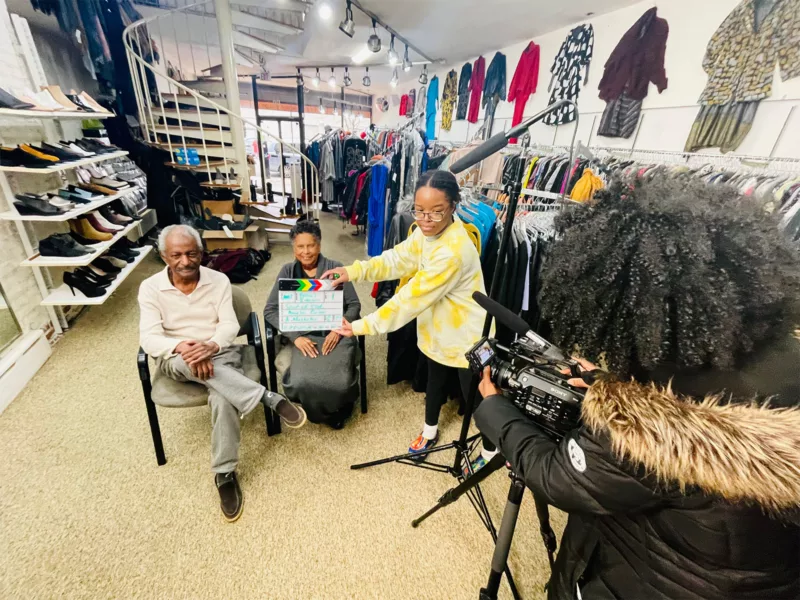
ID: Two seated figures, Ted and Miriam Hall, smile at the video camera, while Production Assistant Mahasin Bintuabdulkareemidris holds a clapperboard in front of them. Director of Photography Artina Michelle is pictured from behind, handling a film camera. Behind the figures is the interior of Babe Boutique, with colorful clothing hung on the right wall, and shoes shelved on the left, a spiral staircase between the figures and the entrance.
Roberta Fallon: Did your project exist before you applied to The Velocity Fund? If so, tell me a little about when you started it and why.
Amelia Carter: We started thinking about it in 2020 after the unrest on 52nd St. I lived near Chancellor and 52nd St., and experienced the tear gassing incident by the Philadelphia Police and private police forces on May 31. The incident motivated our team to explore different perspectives on the future of 52nd St. Given my background in economic development, particularly with Germantown CDC, I was keen on examining the history and future of predominantly Black business corridors. I believe these corridors play a crucial role in the sustainable development of Black communities in Philadelphia. For the project, it was important to showcase diverse perspectives to highlight that there is no singular consensus within the community regarding the future of 52nd St.
Roberta: Does your project have a completion date or do you envision it as ongoing?
Amelia: We predominantly wrapped filming in all of 2022 and I’m now working with an editor. We hoped to finish editing this spring and if we need any other shots, we’ll go get those, but I think we’re finally hitting the end stages. Hopefully this summer, we will complete the film. Fingers are crossed (laughs).
Roberta: How does The Velocity Fund help you move your project forward?
Amelia: I’ve really enjoyed the community and network that The Velocity Fund helped me to build. Through the fund I actually met someone who will star in the film. Her name is Gilletta “Gigi” McGraw. She was a Velocity grantee this year for her project Black in the Days. She was planning to do a guerrilla bike performance down 52nd St. where she recites her memories of the street to an audience of bystanders. We thought that would be a really creative way to capture the history of the street and some of the topics that are harder to tackle. I was introduced to her through The Velocity Fund’s fall gathering of Grantees. At the gathering, I also met Li Sumpter, who I then ended up working with at Monument Lab. She hosts the Monument Lab podcast called Future Memory. Now I have some really great connections with folks who have come through The Velocity Fund and I really appreciate the network and community-building that The Velocity Fund offers. The funding itself is instrumental. It’s what helped us pay for our editor. I’m really appreciative of that.
Roberta: Is the $5,000 from Velocity Fund enough to fund your project? If not, are you seeking other funds to help with your budget?
Amelia: We got primary funding from the Independence Public Media Foundation.
Roberta: What’s your role in the project? And who is helping with what aspect of the work?
Amelia: I’m the director and producer. Shout out to Raishad Momar and Aidan Un for their early work on the project as cinematographers and co-producers; Gabe Coffey, who is the editor; and Artina Michelle, who is Director of Photography. Their technical skills and knowledge have been pivotal. Also, the businesses on 52nd St., who have been incredibly supportive and willing to share stories with us.
Roberta: Do you have events upcoming for the project?
Amelia: We don’t have any events scheduled yet, unfortunately. People can visit my Instagram page for updates @ameliamcarter
Roberta: What’s the best possible outcome of your project?
Amelia: The best outcome of my project is for the film to facilitate a meaningful and introspective dialogue about our community. I aim for it to be a catalyst for discussing our Black business corridors in a thoughtful and intergenerational manner. Ultimately, I hope the conversations sparked by the film can empower us to be self-sufficient and self-actualized, aligning with the shared message from all the interviewees I spoke to.
Roberta: When did you know you were an artist? Talk about that realization a little, and how you got to where you are with your art today.
Amelia: I always really wanted to be an artist but that wasn’t accessible to me because I didn’t have any kind of profound natural talent or the formal education to create. So, it took me a really long time. I was someone who definitely came late to the practice. I started off with mosaic art, in Mt. Airy, with Jessica Liddell at her studio Bella Mosaic. During that time, I did a large-scale glass mosaic installation for Art in the Open 2016. The piece was about the 7th Ward and was informed by W.E.B. Dubois’ Philadelphia Negro. The installation was called E[race]ure: Mapping Community Change and told the story of that historically Black neighborhood in Philadelphia. Although I love mosaics, they were not the right medium to have the kind of conversations I wanted to have through art, so that’s why I switched to film as my primary practice.
While I was in my position at the South Asia Center, at the University of Pennsylvania, I had the opportunity to make my first film project, Until and Unless: Decriminalizing Queer India. That project taught me the power of film in education and advocacy. Through a US and India tour, the film was ultimately used as a tool for my work in global education and the work of local advocates based out of India who were working to repeal Penal Code 377, the anti-sodomy law of India.
As I continued to do my organizing work, film continued to emerge as the best method to move a message forward. I made a film, Testimony: 52nd St. and the Invisible Violence of Penn, that was about the tear gassing of 52nd St. and how the Penn police and other private police forces came to aid the Philadelphia Police in their crackdown on May 31, 2020. That was a short, stop-motion animation film. I made that in collaboration with good friends of mine who are based out of southern India, and that film ended up winning the Shine Award at BlackStar Film Festival in 2021.
I’ve really enjoyed my creative journey. It’s definitely been a saving grace for me. I’m happy to keep evolving and refining my voice as an artist.
Roberta: Who is your community? It’s different from your audience. They can overlap. But talk about both.
Amelia: As I continue to age and grow, my perception of community is evolving alongside my changing political beliefs. I now see my community as any group of individuals, regardless of their self-identified labels, who are open, willing, and committed to engaging in honest and self-reflective conversations. Building a community based on these values is different from simply identifying an audience. In the past, I had a narrow-minded view of who my community should be, focusing on specific political ideologies and identity categories. However, I have come to realize the limitations and skewed perspective that resulted from this closed-off approach. I now seek to broaden my community, embracing diverse perspectives and experiences. Building this community requires trial and error, as it can be challenging to find the right fit. There is a risk of judgment from others, but I am willing to take that risk. Through this film, I am attempting something different, and its reception by the larger community will be a testament to the ongoing evolution many of us are experiencing. We are all grappling with the past few years, seeking to redefine ourselves and make sense of the current state of life post-2020.
Roberta: How about the audience? Who is the big audience?
Amelia: The primary audience for Spirit on 52nd St. is Black residents in Philadelphia, although the conversation is relevant to anyone living in urban communities. We are all grappling with the rapid changes in our cities and trying to find our place within them. Questions surrounding gentrification, community improvement without displacement, and the acceptable nature of urban evolution are crucial to this dialogue. I am particularly interested in engaging with individuals who approach these questions with critical thinking.
To progress in this conversation, it is essential to humble ourselves and acknowledge that we don’t have all the answers. Judging others for their attempts to address these complex issues is counterproductive. Instead, we need to embrace a mindset of exploration, learning from our mistakes, and coming together in unity. Blaming and finger-pointing only hinder our ability to find better solutions. After three years of deeply engaging in this conversation, this is where I have personally arrived.
More about The Velocity Fund
The Velocity Fund gives grant awards directly to Philadelphia-based artists for their experimental and collaborative work. Artblog applauds The Velocity Fund for its stellar five-year history of bringing $2,500 and $5,000 grants to artists. We are eager to learn about the forward-looking projects that will be selected and supported, in The Velocity Fund’s sixth year. TVF applications are open until midnight, June 6, 2023, for 2023–2024 projects. Awards will be announced in September. Find out more about The Velocity Fund at their website.


